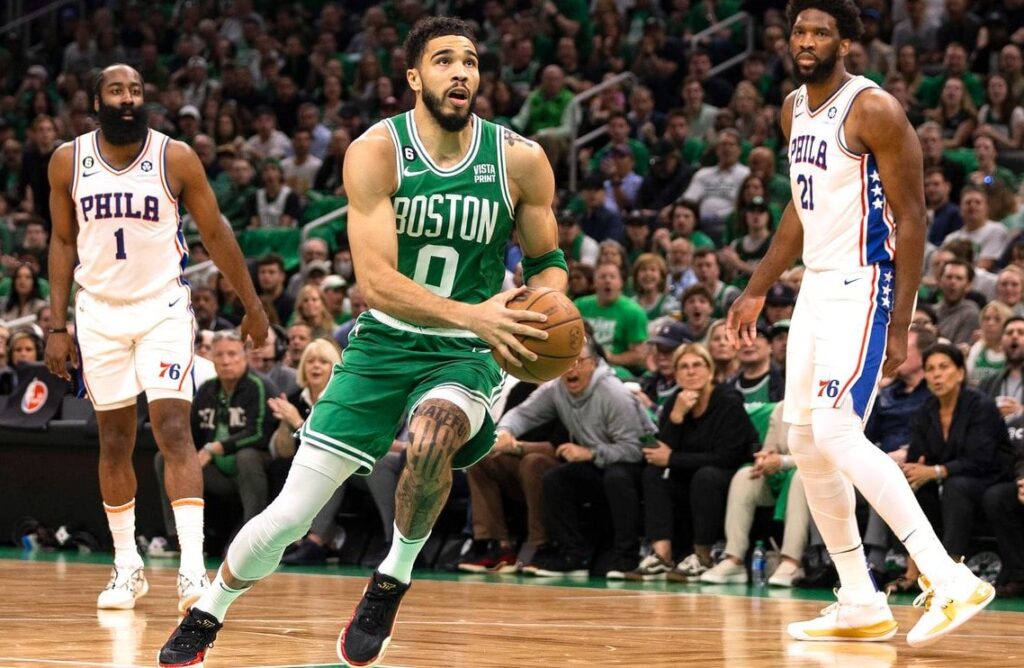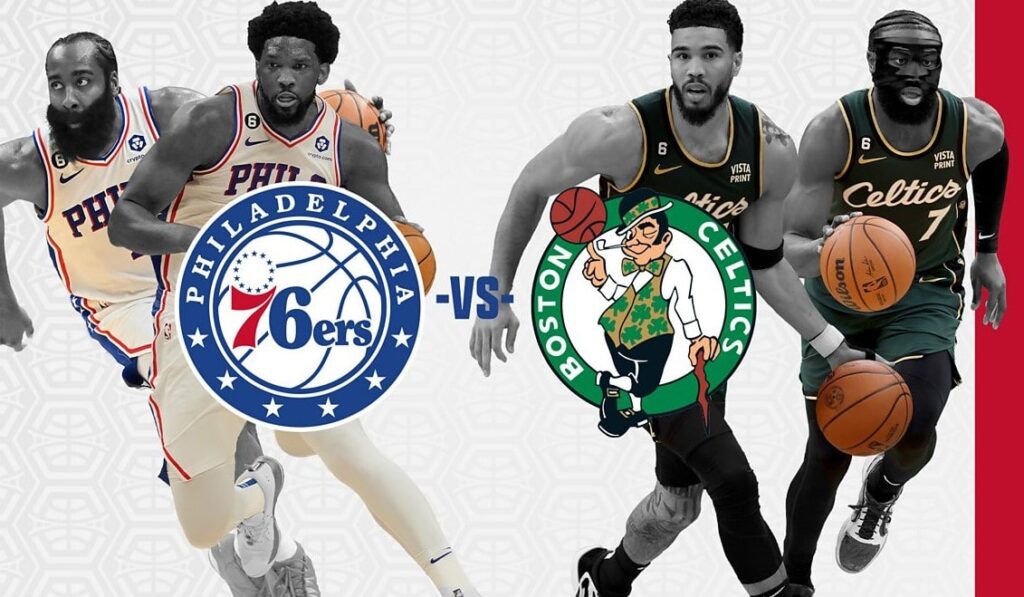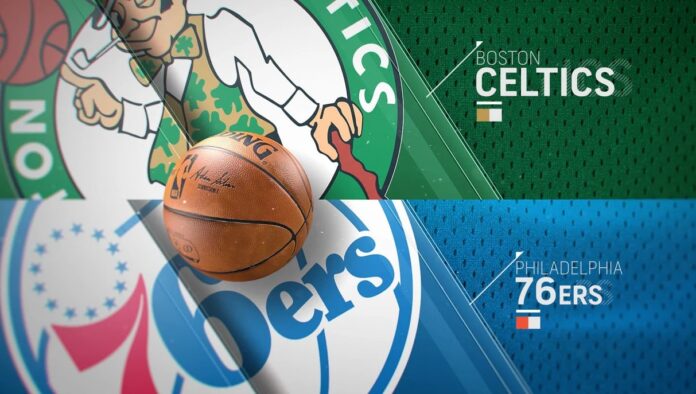The Philadelphia 76ers are a professional NBA club based in Philadelphia, established in 1946. Known as the “Sixers,” they have won three titles (1955, 1967, and 1983) and have a legendary past. Wilt Chamberlain, Allen Iverson, and Julius Erving are all legendary players. The team’s colors—blue, white, and red—stand for the spirit of Philadelphia. The Boston Celtics are a legendary NBA club that was created in 1946 and is headquartered in Boston. Legendary players like Paul Pierce, Larry Bird, and Bill Russell are part of this team, which is well-known for winning a record 17 titles. The Celtics, who are well-known for their green and white uniforms, represent a tradition of collaboration, creativity, and superior basketball.
Table of Contents
Introduction
One of the fiercest and longest-running rivalries in NBA history is that between the Boston Celtics and Philadelphia 76ers. With a history that spans decades and includes famous players and moments, these two Eastern Conference powerhouses have engaged in a ferocious struggle for supremacy. Each game is determined by the performances of individual players, which frequently tip the scales in favor of one team or the other. Player statistics take center stage in every 76ers vs. Boston Celtics game, highlighting who performed well under duress, managed the boards, and coordinated backcourt moves. This article offers a detailed analysis of player statistics from recent meetings between these two teams, shedding light on how individual efforts affect the results of games.
Historical Context

The 76ers and Celtics rivalry has roots in the NBA’s early years, when the sport was shaped by legendary fights between Hall of Famers like Wilt Chamberlain and Bill Russell. Both teams have had many highs and lows throughout the years, but their spirit of competition has not altered. Numerous playoff series have pitted them against one another, including notable encounters in the 1960s, 1980s, and more recently. From Chamberlain vs. Russell to more contemporary player contests between Joel Embiid and Al Horford or Jayson Tatum, each age introduced new rivals within the rivalry. Individual bravery and team performance define this competition, where the result is frequently determined by exceptional efforts. Players like Tatum and Embiid, for example, have frequently been the decisive elements in recent years because to their leadership on the floor, defensive prowess, and scoring bursts. Every new game is built up by these matches, which raises the bar for both players and spectators.
Recent Encounters
Drama, intensity, and elite performances have been abundant in the most recent games between the 76ers and Celtics. In their meetings, there have been hotly contested scores, overtime endings, and outstanding individual performances. For instance, Embiid put on a dominant display with a double-double in a recent game. Tatum replied at the same time with a strong shooting performance, showcasing his ability to score both inside and outside the paint. Tyrese Maxey and Jaylen Brown, meanwhile, demonstrated quickness and agility, frequently converting defense into rapid offense. There are several instances in every game where particular statistics—such as field goal percentages, free throw accuracy, assist totals, and defensive statistics like thefts and blocks—tell the tale. Whether it’s the 76ers’ inside-out offense centered around Embiid’s dominance in the post or the Celtics’ fast-paced, perimeter-focused approach, these figures show the type of play each club brings to the court.
Player Performance Metrics

A better understanding of the teams’ dynamics and their areas of strength and weakness may be obtained by examining individual player data from previous games. Since both sides have excellent shooters, scoring is the main priority. Brown provides supplementary scoring to provide the Celtics a well-rounded offense, and Tatum’s average points per game frequently reflects his ability to dominate games offensively. With his ability to draw fouls and hit a high percentage of free throws, Embiid frequently leads the 76ers in scoring.
Rebounding statistics reveal more than just scoring. Playing important roles beneath the hoop, Embiid and Horford frequently lead in rebounds, demonstrating their command of the paint. Meanwhile, Assists emphasizes the division of playmaking duties. Since James Harden left the 76ers in a trade, Maxey has had to shoulder a larger playmaking burden. He has adjusted by accumulating more assists and directing the team’s offensive flow. Derrick White has taken on additional playmaking responsibilities for the Celtics as a result of Marcus Smart’s departure, and he has continuously performed well in recent games. On the less glamorous end of the court, where hustle, anticipation, and placement are crucial in neutralizing opponents, defensive statistics such as thefts and blocks show each player’s impact.
Impact of Star Players
Game results are regularly impacted by star players like Tatum for the Celtics and Embiid for the 76ers. Because of his stature, speed, and shooting ability, Embiid, the current MVP, is a dangerous opponent for any defense. His many double-teams forced by his presence in the paint provide his teammates easy opportunities. Tatum, on the other hand, can adjust to different defensive tactics because to his versatility as a scorer, whether he’s driving to the basket or sinking deep threes. Tatum’s approach is enhanced by Brown’s agility, which creates a well-rounded offense that challenges opponents. Tatum’s shooting and scoring efficiency, Embiid’s domination in rebounds and blocks, and Brown’s ability to complete fast breaks and secure steals are all indicators of each player’s role. When these elite players perform well, it frequently determines the outcome of the 76ers vs. Celtics game.
Bench Contributions
Bench players may make all the difference in games where the starting lineup fights to a virtual standstill. Players like Sam Hauser and Payton Pritchard, who come off the bench to support the Celtics, give depth, consistent shooting, and enthusiasm to keep up the team’s pace. Similarly, the 76ers depend on backups like Paul Reed and De’Anthony Melton. When players take a break, Melton’s defensive vigor and three-point shooting, along with Reed’s ability to block shots and grab rebounds, give vital backup. Because they spend less time on the court, bench players frequently have high efficiency statistics, and their ability to change or sustain momentum throughout a game is crucial.
Statistical Comparisons
Shooting percentages from three-pointers, free throws, and field goals provide information about each team’s offensive effectiveness when comparing team statistics. Players like Tatum and Brown lead the Celtics, who place a strong emphasis on three-point shooting. The 76ers, on the other hand, frequently score in the paint thanks to Embiid’s high rate of foul calls and free throw conversions. Another important statistic, turnover rates, reveal which team is more adept at managing pressure and minimizing mistakes. Although both sides want to reduce turnovers, in hotly contested games, the team with fewer errors usually wins. The Celtics, who are renowned for their quick breakouts, transform thefts into transition scores by taking advantage of opponents’ mistakes.
Injury Reports and Their Effects
Every 76ers vs. Celtics game is significantly impacted by injuries. Teams have to adjust fast when important players are sidelined since their absence is felt. For instance, the 76ers lose a key defensive and scoring presence when Embiid is sidelined, which frequently causes the game plan to change to one that is more perimeter-focused. In the same vein, other Celtics players must step in to cover for Tatum or Brown when they miss time. Pre-game analysis depends heavily on injury reports, as they affect defensive matchups, lineup selections, and team strategy as a whole.
Coaching Strategies

A key component is coaching, with Joe Mazzulla of the Celtics and Doc Rivers (who was recently replaced by Nick Nurse for the 76ers) using distinct strategies to take advantage of one another’s flaws. Rivers frequently used Embiid as the focal point of his plays, taking advantage of his ability to control the area and generate fouls. Nurse, on the other hand, has a reputation for coming up with innovative defensive plans that may provide fresh tactics against the Celtics’ attack. Mazzulla encourages his squad to seize opportunities by emphasizing three-point shooting and quick transitions. Player statistics and the entire flow of the game are greatly impacted by coaching decisions, whether they include defensive formations or the timing of replacements.
Conclusion
Player statistics from the 76ers vs. Celtics game depict a tale of ability, strategy, and competitive spirit that goes well beyond simple numbers. Every statistic, from Tatum’s scoring runs to Embiid’s post moves, adds to a greater story of competition and tenacity. Fans gain a greater understanding of each game by examining these player statistics, which bring to light the subtleties that make basketball so alluring. The individual and team statistics from each game will continue to change as both sides react and adapt, providing new information and forecasts for upcoming encounters in this legendary rivalry.



